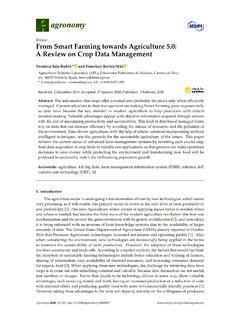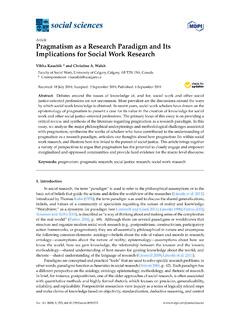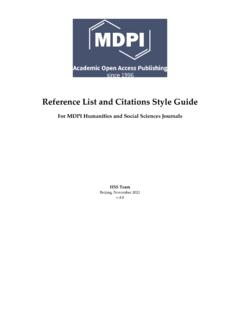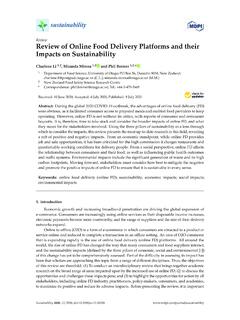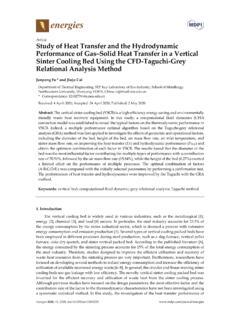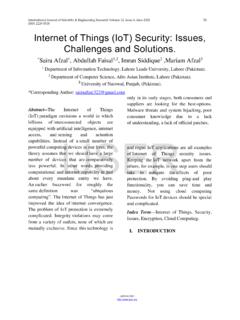Transcription of IoT Privacy and Security: Challenges and Solutions
1 Applied sciencesArticleIoT Privacy and security : Challenges and SolutionsLo ai Tawalbeh1,*, Fadi Muheidat2, Mais Tawalbeh3and Muhannad Quwaider31 Department of Computing and Cyber security , Texas A&M University, San Antonio, TX 78224, USA2 School of Computer Science & Engineering (CSE), California State University,San Bernardino, CA 92407, USA; of Computer Engineering, Jordan University of Science and Technology, Irbid 22110, ( ); ( )*Correspondence: 10 May 2020; Accepted: 10 June 2020; Published: 15 June 2020 Abstract: Privacy and security are among the significant Challenges of the Internet of Things (IoT).Improper device updates, lack of efficient and robust security protocols, user unawareness, and famousactive device monitoring are among the Challenges that IoT is facing.
2 In this work, we are exploringthe background of IoT systems and security measures, and identifying (a) different security andprivacy issues, (b) approaches used to secure the components of IoT-based environments and systems,(c) existing security Solutions , and (d) the best Privacy models necessary and suitable for differentlayers of IoT driven applications. In this work, we proposed a new IoT layered model: genericand stretched with the Privacy and security components and layers identification. The proposedcloud/edge supported IoT system is implemented and evaluated. The lower layer represented bythe IoT nodes generated from the Amazon Web Service (AWS) as Virtual Machines. The middlelayer (edge) implemented as a Raspberry Pi 4 hardware kit with support of the Greengrass EdgeEnvironment in AWS.
3 We used the cloud-enabled IoT environment in AWS to implement the toplayer (the cloud). The security protocols and critical management sessions were between each ofthese layers to ensure the Privacy of the users information. We implemented security certificates toallow data transfer between the layers of the proposed cloud/edge enabled IoT model. Not only is theproposed system model eliminating possible security vulnerabilities, but it also can be used alongwith the best security techniques to countermeasure the cybersecurity threats facing each one of thelayers; cloud, edge, and :Internet of Things; security policy; cloud computing; edge computing; privacy1. IntroductionThe Internet of Things (IoT) refers to a concept of connected objects and devices of all typesover the Internet wired or wireless.
4 The popularity of IoT or the Internet of Things has increasedrapidly, as these technologies are used for various purposes, including communication, transportation,education, and business development. IoT introduced the hyperconnectivity concept, which meansorganizations and individuals can communicate with each other from remote locations Ashton invented the term IoT in the year 1999 for promoting the Radio Frequency Identification(RFID) concept, which includes embedded sensors and actuators. However, the original idea wasintroduced in the 1960s. During that period, the idea was called pervasive computing or embeddedInternet. Ashton presented the IoT concept to improve supply chain activities. However, diversefunctionalities of IoT has helped it to gain strong popularity in the summer of 2010.
5 The Chinesegovernment gave strategic priority on IoT by introducing a five-year plan. About billion IoTdevices exist in the current world [1]. The mass explosion started in 2011 with the introduction of homeautomation, wearable devices, and smart energy meters. The rapid explosion of IoT has benefittedAppl. ,10, 4102; ,10, 41022 of 17organizations and in various ways improved market research and business strategies. Similarly,IoT has improved the lifestyle of individuals by introducing automated services. However, such anuncontrolled explosion has increased Privacy and security unconscious use, not changing passwords, and the lack of device updates have increasedcybersecurity risks and access to malicious applications to the IoT systems sensitive inappropriate security practices increase the chances of a data breach and other threats.
6 Most ofthe security professionals consider IoT as the vulnerable point for cyber attacks due to weak securityprotocols and policies. Even though several security mechanisms were developed to protect IoT devicesfrom cyber attacks, security guidelines are not appropriately documented [2]. Thereby, end-users couldnot utilize protective measures to avert data attacks. Hackers developed different kinds of malware toinfect the IoT devices since the eve of 2008. They designed various phishing techniques to provoke theemployees or individuals to share sensitive data [3]. Therefore, corporate workstations and personaldevices often face Privacy violations due to high-profile attacks. If device manufacturers and securityexperts assess the cyber threats accurately, they can develop an efficient protective mechanism toprevent or neutralize cyber enabled devices have been used in industrial applications and for multiple businesspurposes [4].
7 The apps help these businesses to attain a competitive edge over their , due to the excessive adoption of various smart devices with data sharing and integration,the Privacy and data breach becomes a significant concern to most businesses, as it interrupts the flowof work, activities, and network services. It is essential to have professionals to overcome these threatconcerns and develop comprehensive security measures and policies to protect their business assetsand ensure services continuity and stability. For example, smart kitchen home IoT enabled appliancesconnected to the local network can be a source of the breach for hackers to get access to the businessand/or personally sensitive data or to manipulate and interrupt the business day new technologies emerge, or changes are made to existing ones.
8 Consider the latestadvances in the 5G network, for example. 5G is expected to play an essential role in the IoT systemsand applications. It is getting the researchers attention and curiosity about the possible security andprivacy risks, with its high frequency and bandwidth. Yet, the short wavelength imposes a changein the infrastructure, hence the need for more base stations to cover the same area covered by otherwireless technology. This new structure imposes more threats, such as fake base stations. It is essentialto understand the security risks and potential this work, we aim to provide an overview of the IoT applications, benefits, and potentialrisks. Additionally, to build a framework to study and further develop best security practices byeither implementing and analyzing current existing schemes or developing new ones.
9 Based onthe findings, we provide recommendations to avoid such risks and to remedy the possible securityvulnerabilities. This work will guide regulatory agencies to continue enforcing policies, educatingend-users and entities, and stakeholders involved in IoT to develop and apply more appropriatesecurity and Privacy built our model using Amazon Web Service (AWS) as proof of concept, which later translatedto actual physical systems of sensors nodes mimicking general IoT structure. By making the system,we can deploy and study different security approaches by building real sceneries and adopted a narrative review methodology to explore the history and background of the IoTsystems, their security and Privacy issues, and the corresponding countermeasures.
10 We proposedour own view of the generic and stretched IoT model and its Privacy and security concerns. We builtand studied a cloud/edge supported IoT model consisted of a virtual machine (sensors), and edgenode (Raspberry Pi), and cloud services (AWS). This setup was designed to evaluate the model weproposed in the following sections in this paper. Our work does not provide details on the different IoTapplications (smart health, smart cities, supply chain, transportations, etc.); their features, advantages,and Challenges , or the possible security risks or threats among these applications. The literature is richAppl. ,10, 41023 of 17with such content. In this work, we preferred to have a general overview with proof of concept and laythe ground for further analysis and rest of this paper organized as follows: the next section presents a literature review followedby IoT security and Privacy Challenges .
